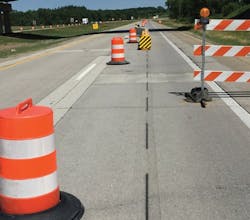Michigan DOT implements first all-wet reflective work zone standard in the nation
Michigan’s Department of Transportation (MDOT) had been using wet reflective optics in its permanent pavement markings on certain larger construction projects for years when officials decided to establish a standard to require full wet reflectivity in its work zones. MDOT wanted to increase safety and visibility in construction zones, where changing lane assignments combined with rain and darkness can make it difficult to see temporary markings without wet reflective optics.
In 2015, the department’s work zone team worked with local contractor PK Contracting to test wet reflective paints for performance. After developing and selecting the permitted products—including 3M’s all-weather elements and temporary tape as well as others—MDOT implemented the new standard for all wet reflective work zones in the state in 2016.
The guideline mandating the use of temporary wet reflective tape and paint in work zones is the first of its kind in the country and went into full effect in 2017, according to MDOT Work Zone Delivery Engineer Chris Brookes.
Testing solutions for the standard
MDOT had already been using wet reflective temporary tape but needed to develop a wet reflective waterborne paint to meet the new standard. After teaming up with PK Contracting and 3M, testing was done to pinpoint the right thickness and composition of the paint for Michigan’s roads. “The challenge was making a paint that was temporary but had enough binder to hold on to the wet reflective optics long enough for a work zone stage” said MDOT Work Zone Tech Specialist Chuck Bergmann.
“It definitely took rounds of various testing and different [experiments by] trial and error until we really felt that we were comfortable with the performance that they got out of it,” said 3M Government Transportation Safety Specialist Brad Stone.
Testing was done to assess the performance of paints with varying thicknesses and reflective bead loads. Bergmann stated they put down 10 to 12 different paint applications and bead loads for a two-month period, which is the average stage length for a construction zone.
After reviewing all the options, they selected the paint application with the strongest performance. This paint had an increased thickness of 18 mils compared to the 15 mils the department was using previously. It also included 6 pounds per gallon of glass beads and 4 pounds per gallon of the wet reflective optic. Bergmann said because of the increased thickness, they had to slow down the speeds of the paint trucks from 10-18 mph to 8 mph.
“We didn’t want the optics to roll in the paint and get totally covered, and we didn’t want them bouncing out of the line either,” Bergmann said. “So far it seems to be working well.”
Implementation & feedback
Before implementing the new standard, MDOT’s Brookes said data showed that about 35 percent of work zone crashes occurred during dusk, dawn or rainy periods. As a Toward Zero Deaths (TZD) partner, the department knew it was important to prioritize construction zone line markings to make lane assignments clearer.
“It is very important to fully understand from the driver’s perspective, where you are supposed to be to help reduce crashes and help improve the overall safety,” Brookes said.
Since the standard is so new, MDOT doesn’t yet have data to illustrate its effects. But since the new rules were established, the department has received positive feedback about the visibility of work zone lines. “It’s been fairly smooth now that we have all of our specs figured out and all of the language correct in our documents,” Brookes said. “Since we’ve made that changeover, there really hasn’t been any issues or any negative feedback that we’ve received to date. It’s all been positive.”
Bergmann said another benefit is the ability for workers to jump into a truck and stripe a wet reflective paint or tape line, which is more efficient than the tedious process of putting down temporary raised pavement markers that can provide the same affect. Along with ensuring that the motoring public in Michigan is guided from point A to point B as safely as possible, MDOT is setting an example for wet reflective work zones across the country.
“MDOT prides itself in being a leader in testing and being innovative, and this is just one other way that we were meeting the goals that were set forth in our department,” Brookes said.
